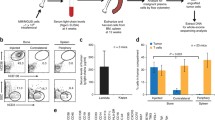Abstract
The severe combined immune deficient human (SCID-hu) myeloma model is the only available model in which primary myeloma cells grow in vivo in a human bone marrow microenvironment. A SCID mouse receives an implanted human fetal bone into which myeloma cells are directly injected. Through interaction with the human bone marrow microenvironment, the myeloma cells induce typical myeloma manifestations in the SCID host, such as the appearance of M protein in the serum, and changes in the implanted human bone, which often result in osteolysis of the human bone. The model provides the only platform for in vivo investigation of the biology and therapy of primary human myeloma in a human microenvironment. This chapter describes in detail all the steps necessary to establish this model and evaluate its success.
Access this chapter
Tax calculation will be finalised at checkout
Purchases are for personal use only
Similar content being viewed by others
References
Kyoizumi S., Baum C. M., Kaneshima H., McCune J. M., Yee E. J., and Namikawa R. (1992) Implantation and maintenance of functional human bone marrow in SCID-hu mice. Blood 79, 1704–1711.
Yaccoby S., Pearse R. N., Johnson C. L., Barlogie B., Choi Y., and Epstein J. (2002) Myeloma interacts with the bone marrow microenvironment to induce osteoclastogenesis and is dependent on osteoclast activity. Br. J. Haematol. 116, 278–290.
Pearse R. N., Sordillo E. M., Yaccoby S., et al. (2001) Multiple myeloma disrupts the TRANCE/osteoprotegerin cytokine axis to trigger bone destruction and promote tumor progression. Proc. Natl. Acad. Sci. USA 98, 11,581–11,586.
Yaccoby S. and Epstein J. (1999) The proliferative potential of myeloma plasma cells manifest in the SCID-hu host. Blood 94, 3576–3582.
Yaccoby S., Barlogie B., and Epstein J. (1998) Primary myeloma cells growing in SCID-hu mice—a model for studying the biology and treatment of myeloma and its manifestations. Blood 92, 2908–2913.
Author information
Authors and Affiliations
Editor information
Editors and Affiliations
Rights and permissions
Copyright information
© 2005 Humana Press Inc.
About this protocol
Cite this protocol
Epstein, J., Yaccoby, S. (2005). The SCID-hu Myeloma Model. In: Brown, R.D., Ho, P.J. (eds) Multiple Myeloma. Methods in Molecular Medicine™, vol 113. Humana Press. https://doi.org/10.1385/1-59259-916-8:183
Download citation
DOI: https://doi.org/10.1385/1-59259-916-8:183
Publisher Name: Humana Press
Print ISBN: 978-1-58829-392-3
Online ISBN: 978-1-59259-916-5
eBook Packages: Springer Protocols




